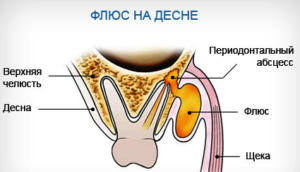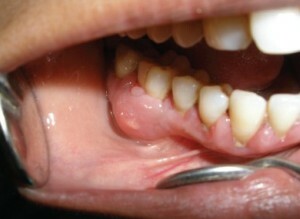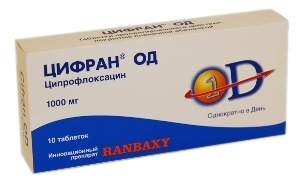 It is believed that toothache itself is strong. It is almost impossible to endure it.
It is believed that toothache itself is strong. It is almost impossible to endure it.
There are many ailments that can cause it. One of them is the flux.
Flux is a purulent, inflammatory process that proceeds in an acute form in the connective tissue surrounding the tooth. The disease is complex and very unpleasant, it develops quickly.
Inflammation of the periosteum as a result of ingestion of microorganisms from the oral cavity, carious cavity of the tooth, blood or lymphatic system. In modern medical terminology - this ailment is called periostitis.
Contents of
- About the causes - in detail
- Complaints of patients and symptoms
- What means of traditional medicine to choose?
- Treatment and Prophylaxis Rinse
- This is really effective!
- Compresses
- Use of antibiotics: the choice and effectiveness of
- medications What can not be done with the development of the disease?
- When to go to dentistry?
- How to help your child?
- Recommendations for prevention
About the causes - in detail
Now about the most common reasons contributing to its appearance, there are several of them:
- Caries in the started form .This cause most often contributes to the development of the disease. If you do not start caries treatment in time, inflammation of the tooth pulp develops. Sometimes there are painful sensations that themselves are lost. The tooth of the tooth gradually begins to die. After a while pulpitis becomes periodontitis. The body begins to ache during hypothermia and more often at night. This condition lasts several days. The painful condition stops suddenly. The canals of the tooth are open, bacteria easily enter them. Development of bone inflammation begins. The amount of pus increases daily, it gradually gets to the gum. The flux develops.
- The seal is poorly , or rather the pulp is poorly cleaned before sealing. If the remains of the channel remain in the canal, they can cause an inflammatory process in the bone. In order to check the quality of the filling, it is necessary to do an x-ray.
-
 The presence of deep periodontal pockets .They will get food, and at home it is very difficult to get it from there. An inflammatory process begins between the gum and the tooth.
The presence of deep periodontal pockets .They will get food, and at home it is very difficult to get it from there. An inflammatory process begins between the gum and the tooth. - Mechanical trauma, dental cyst, stress, colds - all this can trigger the appearance of flux.
Complaints of patients and symptoms
The development of the disease has two stages:
- early - accompanied by pain, passes without purulent discharge;
- purulent - is characterized by the presence of a purulent inflammatory process.
Most often there are such complaints of the afflicted: 
- The intolerable toothache , especially it is felt when pressing on the gum. There is swelling of the mucosa and tissues around the tooth. There is a cone filled with pus.
- If the flux on the upper jaw, swells up the cheeks and lips of the .There is swelling above the eyelid and under the eye. The pathology on the lower jaw causes swelling of the cheek, chin, the lymph node increases under the jaw.
- The temperature rises to 38 degrees, there is a general malaise of .It is worth saying that the symptoms are much more pronounced in adults than in children and the elderly.
- During the acute form of the disease, the gum, upper lip, crease between the nose and lip strongly swells. Over time, pus begins to spread to all the muscles of the face and neck.
- The chronic stage is slow. The jaw bone thickens .The inflammatory process is constantly increasing.
What means of traditional medicine to choose?
The method of treating the disease depends on the stage at which it is located and on the condition of the patient. In some cases, you can get rid of the disease or alleviate the condition with the help of traditional medicine.
Treatment with folk remedies is possible:
- at the initial stage of the disease;
- during the period when the inflammatory process stopped;
- together with antibacterial drugs;
- during the course of the disease without complications.
The following forms of traditional medicine are used.
Treatment and prophylactic rinses
For this procedure are used: sage, thyme, baking soda, hyssop, mountain pochechuyny and others.
We offer several recipes for rinsing:
- Take one teaspoon of green tea, brew it in a glass of water, add a little salt. The solution is ready. Use it as often as possible until the pain subsides.
- Four tablespoons of St. John's wort, three spoons of sage, two tablespoons of oak bark mix in one container. Take one tablespoon of the mixture and brew in a glass of steep boiling water. Rinse as often as possible.
- Two tablespoons of thyme pour one glass of steep boiling water. Insist thirty minutes. Filter and several times a day rinse your mouth.

- Treatment with soda. A teaspoon of drinking soda is dissolved in a glass of warm water. Caress the oral cavity every two hours.
- Stomatophyte. This tool will help stop the development of the purulent process, relieve swelling, and anesthetize.
- Two tablespoons of sage fill with one glass of steep boiling water. Filter. Caress your mouth every two to three hours.
It's really effective!
Time-tested recipes:
- Take a rusty nail, heat it on a fire and lower it for a few minutes in a saucer with honey. After that, remove the scale with cottonwood, apply to the diseased gum. Hold, as long as the pain does not subside.
- Mix the ichthyol and streptocid ointment in equal proportions. Apply to the tumor that formed near the tooth, using a cotton swab.

- Ointment using calendula. Dried calendula flowers are ground into powder. Mix with butter without salt in a one to five ratio. The remedy is put on a cotton swab and applied to a sore spot all night.
- Olive, linseed oil and wax are heated on a water bath. All of fifty grams. After all the mass is removed from the fire. Put honey in it. Wait until the mixture cools. The resulting ointment is placed on a cotton ball and applied for two hours to a painful place.
Compresses
They are stronger than rinsing:
- Cook for two minutes cabbage leaf. Wait until it cools down, put it to the sore spot.
- Wet the bandage in a strong sage infusion, mixed with mustard.
- Cotton swab or a piece of bandage moisten in onion juice, apply to the swelling.
- Soda pack. Throw in a bandage baking soda, one teaspoon. The resulting tampon is slightly moistened in water, applied to a sore spot, hold for three hours.
The use of antibiotics: the choice and effectiveness of
 preparations After the diagnosis of "flux", in the opinion of many specialists, the intake of antibiotics is mandatory. Only these drugs can stop the development of the inflammatory process. It is necessary before prescription of medicines, it is necessary to determine the causative agent, the cause of the disease, its stage.
preparations After the diagnosis of "flux", in the opinion of many specialists, the intake of antibiotics is mandatory. Only these drugs can stop the development of the inflammatory process. It is necessary before prescription of medicines, it is necessary to determine the causative agent, the cause of the disease, its stage.
If only the beginning of the disease, the effectiveness of antibacterial drugs will be high: the inflammatory process decreases, the puffiness disappears, as does the infected focus.
In cases of severe pain, anesthetics can be used in parallel with antibiotics. If there are ulcers, then the drugs will become more effective only after surgical intervention.
For each patient, the antibiotic is selected individually. The duration of treatment depends on the stage of the disease.
What can not be done while developing the disease?
During the development of the disease, in no case can:
- do not put a warming compress on the sore spot, in the warmth the bacteria begin to multiply more intensively;
- do not take antibiotics without consulting your doctor;
- do not open the abscess yourself.
When to go to dentistry?
Most often, a specialist is treated if there is a terrible pain and a purulent form of the disease. In this case, surgical intervention can not be avoided.
The operation is performed in the clinic under anesthesia. A notch is made around the aching tooth, the pus is released outside. For its full outflow, drainage is put. Necessarily antibiotics and anti-inflammatory drugs are prescribed. The scheme of taking medications is prescribed by a dentist.
At an early stage of the disease specialist after the examination, prescribes antibiotics and pain medications.
Decides whether to retain the tooth or remove it. Repeated consultation is necessarily appointed, the notch is observed.
How to help your child?
 Periostitis is very dangerous for the health of the child. A disease like blood poisoning can develop. In addition, the flux sometimes leads to tooth loss.
Periostitis is very dangerous for the health of the child. A disease like blood poisoning can develop. In addition, the flux sometimes leads to tooth loss.
Therefore, if the first symptoms of the disease are found, immediately consult a specialist. If you can not immediately bring the child to the doctor, then it should ease the pain and stop the inflammatory process.
For this purpose, folk remedies are perfect. Rinse the mouth with baking soda.
Treatment of flux usually comes down to the removal of the milk tooth and the opening of the cone formed near it. After surgery, the child goes home, the treatment continues under the supervision of the parents.
The doctor prescribes antibiotics and anti-inflammatory drugs that will continue to fight infection. We must strictly adhere to the proposed scheme.
Recommendations for the prevention of
In order not to face this disease, simple rules should be observed:
- One of them is associated with caries prevention .You need to clean your teeth, at least twice a day. For these purposes, choose a soft and gentle brush. Toothpaste should contain fluoride. After each meal, rinse the mouth with water.
- Do not forget to permanently remove tartar .
- Visit the dentist at least twice a year .Thus, you prevent the development of the disease.
- Eat more fruits and vegetables .A perfect option: carrots and apples. In this way, you strengthen the teeth and gums.
- Drink freshly squeezed juices.
- At the first symptoms of the disease, contact an specialist.
